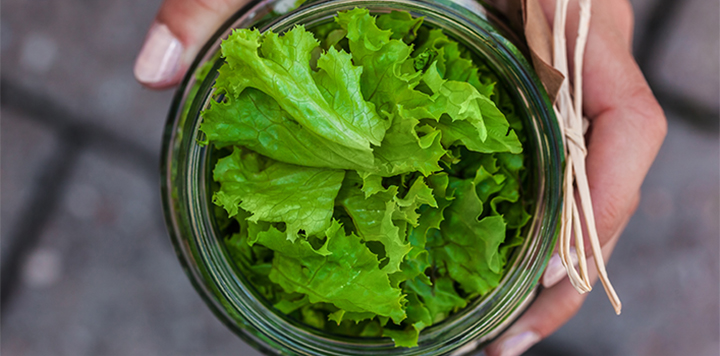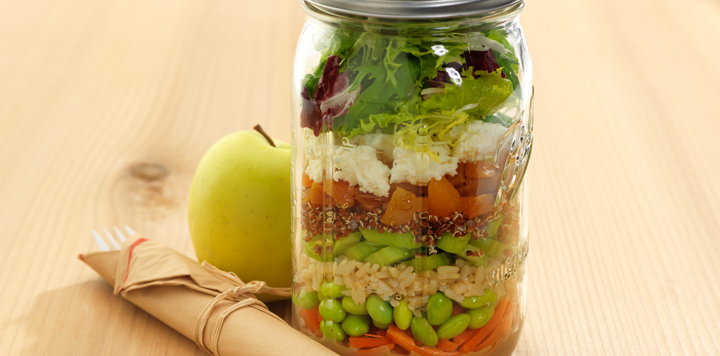From drinks and décor to gardening and crafts, there are plenty of Pinterest-worthy ways to use a mason jar. Naturally, our favorite way to use a mason jar is for packing a salad. It may look easy, but there’s more to making a mason jar salad than meets the eye. With the right layering technique, the ingredients will stay clean and crispy until lunchtime. Pack your next mason jar salad like a pro with these tips.
What You Need
-
- mason jar with an air-tight lid
- salad greens
- salad dressing
- mix of raw and cooked vegetables
- grains like rice, quinoa or pasta
- fresh and dried fruit
- nuts and seeds
- cheese
- protein like chicken or tofu
How to Layer
- Dressing: Pour 1-4 tablespoons of your salad dressing into the bottom of the jar, based on the size of your salad and personal preference.
- Hearty vegetables: Add your hard, chopped vegetables on top of your dressing. They’ll be exposed to the dressing, so use tomatoes, cucumbers, onions, broccoli, cauliflower, asparagus, celery, carrots, peppers, beets or anything else that would taste good marinated or pickled.
- Beans & other veggies: Pile in the ingredients that you don’t want marinated, but can be exposed to the dressing as a second, back-up barrier. Less hearty vegetables like zucchini, green beans, corn and pinto beans would all work.
- Grains: Now it’s time for pasta, rice, barley or other heavy grains.
- Protein and cheese: Next, add any meat, eggs, tofu or cheese. The bottoms layers block the dressing from this layer, which wouldn’t taste good soggy.
- Nuts, seeds & lighter grains: If you want to add any almonds, walnuts, peanuts, sunflower seeds, quinoa, millet or couscous, layer that in next.
- Greens: Last, but certainly not least, chop your greens into bite-size pieces as you place them into the jar.
- Fruit: If you want to add any fruit or berries, they should go at the very top.
Extra Tips
Do ingredients get soggy?
One of the main reasons for using a mason jar to pack your salads is layering the ingredients to avoid sogginess. The more tightly you pack your salad, the less soggy it will be.
What size mason jar works best?
A wide-mouth jar with tight-fitting lid will keep your salad freshest. The wide mouth also makes ingredients easier to pack and shake out again. Use pint size jars for side salads, quart size for single meal-sized servings and 2-quart of larger for multiple servings, like for a picnic or potluck. If you don’t have any extra mason jars around the house, you can buy them at the grocery, craft or hardware store.
How long do mason jar salads last?
Depending on the ingredients, mason jar salads last from five days to a week in the refrigerator – making them especially great as make-ahead lunches for the week. Packing the layers tightly will keep air out so your salads stay fresher for longer.
Do you eat your salad straight from the mason jar?
No – when you are ready to dive in, shake the jar and dump the salad into a bowl or on a plate. Toss the ingredients gently and enjoy!




